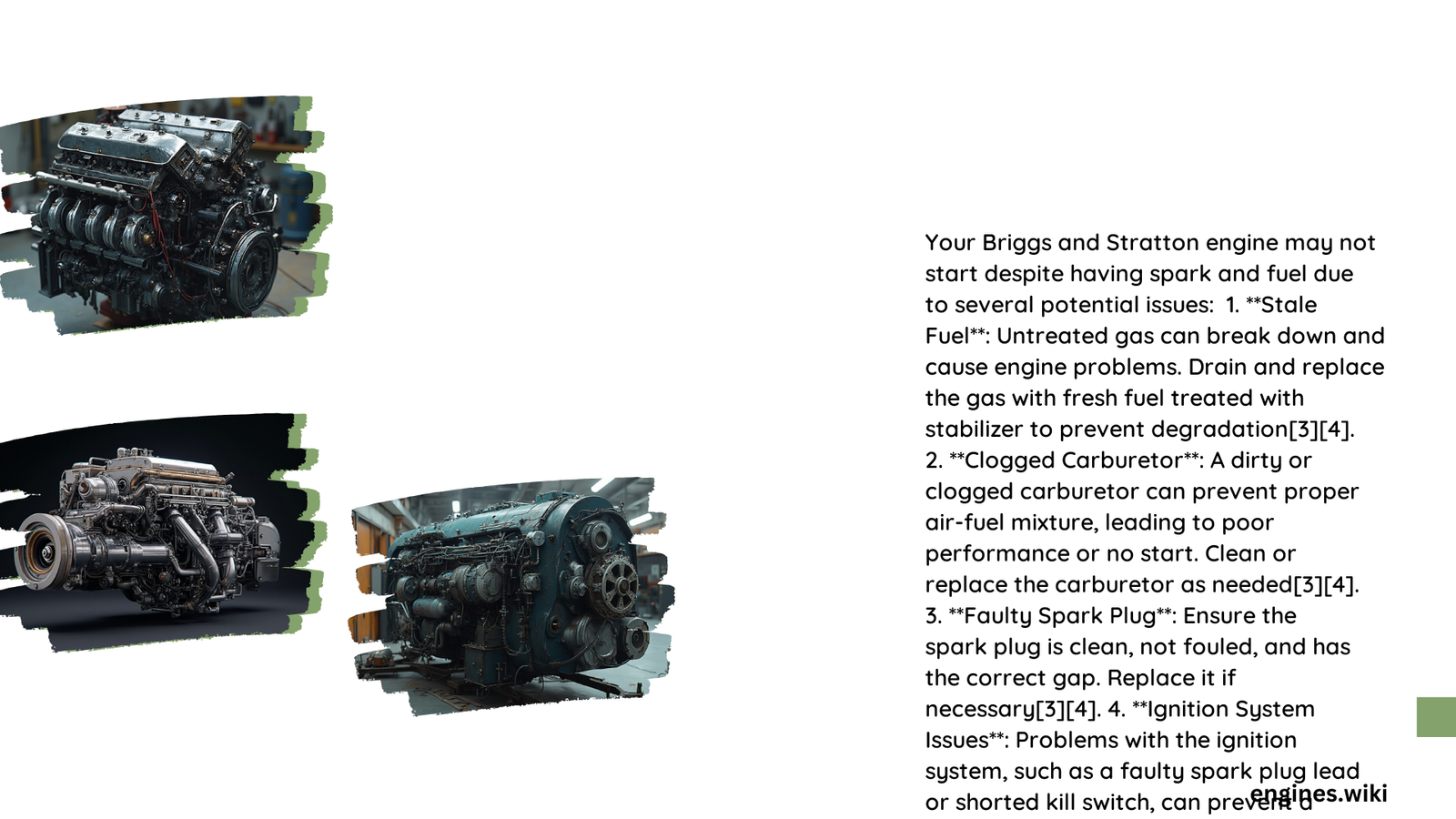If your Briggs and Stratton engine won’t start despite having spark and fuel, several factors could be at play. Common issues include compression problems, valve train issues, flywheel misalignment, carburetor blockages, and fuel quality concerns. This article will explore these potential causes and provide troubleshooting steps to help you diagnose and resolve the problem, ensuring your engine runs smoothly again.
What Are the Main Reasons for a Briggs and Stratton Engine Not Starting?
- Compression Issues
- Valve Train Problems
- Flywheel and Timing Issues
- Carburetor Problems
- Fuel Quality Concerns
Let’s dive deeper into each of these potential causes and explore how to diagnose and address them.
How Can I Check for Compression Issues?

Insufficient compression is a common reason why an engine won’t start, even with spark and fuel. Here’s how to check for compression problems:
- Perform a simple finger test:
- Remove the spark plug
- Place your thumb over the spark plug hole
- Crank the engine
-
If you feel strong air pressure against your thumb, compression is likely adequate
-
Conduct a compression test using a gauge:
- Remove the spark plug
- Insert the compression gauge into the spark plug hole
- Crank the engine several times
- Record the highest reading
- Compare the reading to the manufacturer’s specifications (typically 60-90 PSI for small engines)
If compression is low, potential causes include:
– Worn piston rings
– Damaged cylinder walls
– Leaking head gasket
– Stuck or leaking valves
What Should I Look for in the Valve Train?
Valve train issues can prevent your engine from starting. Here’s what to check:
- Remove the valve cover
- Inspect pushrods for:
- Looseness
- Misalignment
-
Damage
-
Check valve springs for:
- Breakage
-
Weakness
-
Examine rocker arms for:
- Proper movement
- Wear or damage
If you notice any issues with these components, they may need adjustment or replacement.
How Do I Diagnose Flywheel and Timing Problems?
Flywheel misalignment can cause timing issues, preventing the engine from starting. Here’s how to check:
- Remove the flywheel
- Inspect the flywheel key for:
- Damage
-
Shearing
-
Check the crankshaft keyway for:
- Wear
-
Damage
-
Examine the flywheel for:
- Cracks
- Loose magnets
If the flywheel key is sheared or the flywheel is damaged, replace the affected parts to restore proper timing.
What Are the Signs of Carburetor Problems?
Carburetor issues can prevent fuel from reaching the engine properly. Look for these signs:
- Engine starts briefly with starting fluid but won’t run
- Fuel doesn’t reach the cylinder (dry spark plug)
- Engine runs roughly or stalls frequently
To address carburetor problems:
- Clean the carburetor thoroughly:
- Remove the carburetor bowl
- Clean all passages with carburetor cleaner
-
Use compressed air to blow out debris
-
Check and clean specific components:
- Float
- Needle valve
-
Main jet (use a thin wire to clear blockages)
-
Inspect the carburetor gaskets for damage
If cleaning doesn’t resolve the issue, you may need to rebuild or replace the carburetor.
How Does Fuel Quality Affect Engine Starting?
Poor fuel quality can prevent your engine from starting. Consider these factors:
- Age of fuel:
- Gasoline can degrade within 30 days
-
Old fuel may not combust properly
-
Fuel contamination:
- Water in the fuel
-
Dirt or debris
-
Incorrect fuel mixture (for 2-stroke engines)
To address fuel quality issues:
- Drain old fuel from the tank and carburetor
- Clean the fuel system thoroughly
- Refill with fresh, high-quality fuel
- Add a fuel stabilizer if the engine won’t be used frequently
What Are Some Advanced Troubleshooting Steps?
If you’ve checked all the above and your engine still won’t start, consider these additional steps:
- Perform a leak-down test to pinpoint compression issues
- Check the ignition module with a multimeter
- Inspect the crankshaft for damage or misalignment
- Examine the camshaft and lifters for wear or damage
When Should I Seek Professional Help?
If you’ve exhausted all troubleshooting options or lack the necessary tools and expertise, it’s time to consult a professional. Consider seeking help if:
- You’re uncomfortable working with small engines
- The problem persists after trying all suggested solutions
- You suspect internal engine damage
A qualified small engine mechanic can perform advanced diagnostics and repairs to get your Briggs and Stratton engine running again.
By systematically checking these potential issues, you can diagnose and often resolve the problem preventing your Briggs and Stratton engine from starting, even when spark and fuel are present.
References:
1. Briggs and Stratton Won’t Start (but has a spark!)
2. Mower won’t start unless I put gas in the spark plug well
3. Small Engine Problem Solving Tips
4. Troubleshooting small engine problems
5. How to Troubleshoot Your Mower Not Starting
